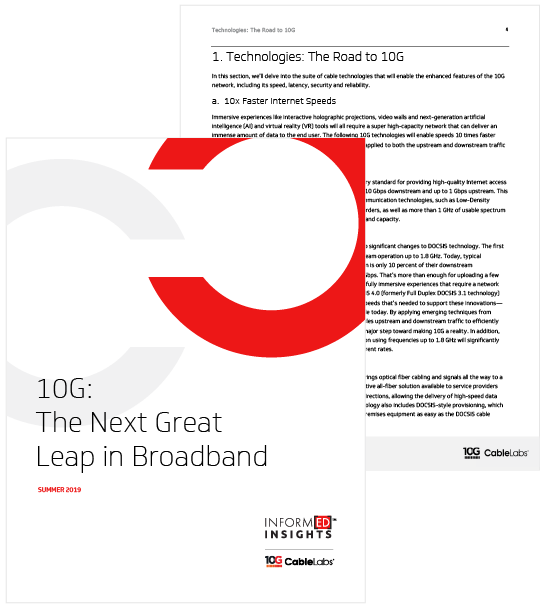SUMMER 2019
10G: The Next Great Leap in Broadband
As technology becomes more crucial to our lives, we need a robust network to support the new hyper-connected, multi-gigabit reality of the near future. We require a network that’s faster, simpler, more reliable and more secure than anything we’ve seen so far—a network we call 10G.
Executive Summary
The 10G platform is a combination of technologies that will deliver symmetric multi-gigabit Internet speeds. It will be 10 times faster than today’s networks and 100 times faster than what most consumers currently experience, and it will offer lower latencies, enhanced security and greater reliability. While 10G is a great leap for broadband, the technologies that enable it are already in development. The cable industry has been anticipating consumer demand for better network performance for years and has invested significant effort into laying the groundwork for 10G. In essence, the same cable networks that deliver 1G today will scale to 10G over the next few years, incrementally increasing speed and capacity as new innovations make their way to the network. This groundwork, coupled with a massive footprint that covers over 85 percent of U.S. households, positions cable as the frontrunner to deliver the myriad new immersive digital experiences that will change the way we live, learn, work and play.
Is 10G a realistic goal? When you consider the increase in cable gigabit service availability from 4 percent to 80 percent of U.S. households in just 2 years, the answer is a resounding “yes!” From regional hub to neighborhood node to residential Wi-Fi, cable continues to focus on improving the end-to-end experience for its customers by steadily increasing capacity and lowering cost in each segment of the broadband network. Furthermore, from December 2014 to June 2017, cable broadband providers increased the number of housing units that had available 200 Mbps or better broadband service in the United States by over 800 percent. By December 2018, cable gigabit was available to 93 percent of housing units passed by cable broadband providers. This well-established track record of increasing broadband availability and performance is a great indicator of cable’s ability to deliver on its 10G promise.
Technologies: The Road to 10G
In this section, we’ll delve into the suite of cable technologies that will enable the enhanced features of the 10G network, including its speed, latency, security and reliability.
10x Faster Internet Speeds
Immersive experiences like interactive holographic projections, video walls and next-generation artificial intelligence (AI) and virtual reality (VR) tools will all require a super high-capacity network that can deliver an immense amount of data to the end user. The following 10G technologies will enable speeds 10 times faster than the 1 gigabit speeds that cable offers today, equally applied to both the upstream and downstream traffic over existing cable hybrid fiber coax (HFC) networks.
DOCSIS® 3.1 Technology
The DOCSIS 3.1 specification is the current industry standard for providing high-quality Internet access over HFC networks, allowing data speeds of up to 10 Gbps downstream and up to 1 Gbps upstream. This release included the latest and greatest digital communication technologies, such as Low-Density Parity-Check encoding and very high modulation orders, as well as more than 1 GHz of usable spectrum that led to a significant increase in network speed and capacity.
DOCSIS® 4.0 Technology
The upcoming DOCSIS 4.0 specifications bring two significant changes to DOCSIS technology. The first is full duplex operation, and the second is downstream operation up to 1.8 GHz. Today, typical broadband customers’ upstream data consumption is only 10 percent of their downstream consumption, with a maximum download speed of 1 Gbps. That’s more than enough for uploading a few videos now and then but is insufficient to support fully immersive experiences that require a network with multi-gigabit speeds in both directions. DOCSIS 4.0 (incorporating Full Duplex DOCSIS technology and Extended Spectrum technology) achieves the breakthrough increase in upstream speeds that’s needed to support these innovations. By applying emerging techniques from wireless networks, full duplex communication enables upstream and downstream traffic to efficiently use the same spectrum at the same time and is a major step toward making 10G a reality. In addition, the complete specification of downstream operation using frequencies up to 1.8 GHz will significantly extend DOCSIS downstream capacities beyond current rates.
10G/25G/50G PON
10 Gbps Passive Optical Networking (10G-PON)[4] brings optical fiber cabling and signals all the way to a home or business. Considered the most cost-effective all-fiber solution available to service providers today, 10G-PON enables 10 Gbps speeds in both directions, allowing the delivery of high-speed data services that customers want. The 10G PON technology also includes DOCSIS-style provisioning, which makes configuring and managing fiber customer premises equipment as easy as the DOCSIS cable modems. Looking forward, emerging 25G PON and 50G PON technologies will continue to multiply all-fiber capacity, allowing cable operators to stay ahead of the high-speed data trends of the future.
Coherent Optics
Point-to-Point (P2P) Coherent Optics technology modulates the amplitude and phase of light to send vast amounts of data at incredibly high speed—up to 100 terabits per second—over a fiber optic network, including the fiber portion of the HFC network. It is already about 40 times more efficient than non-coherent optical technologies, but we’ve figured out a way to make it even better. Because single-fiber use in cable access networks is estimated to grow as much as 60 percent in the next 5 years, we’ve developed Full Duplex Coherent Optics, a brand-new innovation that uses one laser to send data in two directions, over the same fiber at the same time—thus doubling the fiber’s capacity.
Low Latency Enabling the Future of Technology
Today, latency is considered one of the most important network attributes in gaming and video calling, where a network delay of even a few milliseconds can negatively impact the user experience. It will play an even bigger role in the near future, where next-level innovations like holodecks, lightfield displays and 360° video will require virtually delay-free 10G networks that can support many concurrent connections. The following innovations will become central to reaching this goal.
Low Latency DOCSIS®
As of January 2019, Low Latency DOCSIS® (LLD) has become a part of our DOCSIS 3.1 suite of specifications. LLD decreases latency to just 1 millisecond for many latency-sensitive applications, giving customers real-time control over their experience. For example, if you engage in a multi-player online game, you won’t have to worry about freezing or choppiness due to a network delay—a source of frustration for many gamers. Not all Internet traffic is created equal, and some applications require more bandwidth but are resilient to latency and vice versa. Best of all, LLD can be implemented on an existing DOCSIS 3.1 network through a simple, cost-effective software update, enabling latency performance improvements without overhauling the existing HFC network structure.
Low Latency Wi-Fi
Even if a user’s modem has good latency, a poor Wi-Fi connection can still cause a significant “lag”—consecutive delays of varying length—that can ruin an online experience. CableLabs is working on applying some Low Latency DOCSIS technologies to Wi-Fi access points to reduce the latency and jitter of data traffic over Wi-Fi.7 Low-latency wireless technology is also key to reaching mass-market adoption of next-generation high-resolution video technology, such as VR, giving users unprecedented freedom of movement unrestricted by cables or tethers of any kind.
Low Latency Mobile Xhaul
In preparation for nation-wide 5G deployments, mobile operators have been making hefty investments in small cells—small wireless stations that enable the next generation of high-speed, low-latency mobile experiences. The data that’s received by these small cells is routed back to the provider’s switching center via a wired network. This process is called mobile xhaul in the current LTE/4G environment. And because cable is available to over 90 percent of U.S. households and more than half of all European households, its robust networks make for a cost-effective xhaul solution that will continue to meet the latency and speed requirements of LTE, 4G, 5G and beyond.
A Safe and Secure Connected Future
As the number of new digital devices and applications in our lives continues to grow, so will network complexity. Agile and user-friendly network management systems capable of isolating and resolving security threats will become integral to keeping our personal data and business information safe and secure. Read on to learn more about CableLabs® Micronets, a next-generation on-premises network management system that will provide enterprise-level security for your home or office.
CableLabs® Micronets
Because every newly added IoT device with questionable security technology can potentially expose the entire network, we needed a better way to think about network security. And it begins with a smart and easy-to-use network management system like CableLabs® Micronets. Micronets provides highly adaptive and effortless enterprise-level security for home and small business networks using the latest Software Defined Networking (SDN), AI and machine learning technologies. It uses the following tactics:
Network Segmentation
The Micronets system organizes all networked devices into multiple dynamically managed sub-networks—or micronets. This allows it to effectively isolate a security threat before it damages the entire network. For example, if your baby monitor gets hacked, the attackers will not be able to use it to access your home security system on a different micronet.
Secure Network Extension
Micronets provides application interfaces to trusted third parties that simplify and protect the device and user. So, if you use a device such as a glucose tester that maintains continuous connection to a third party, such as a family doctor or a hospital, Micronets can make sure your private data stays safe. Once you take the device home, it automatically joins your network and securely connects to the third-party provider.
Advanced Security Services
Hacking tools and methodologies continuously evolve. That’s why Micronets uses adaptable security technologies, such as device fingerprinting, AI and machine learning–based anomaly detection, to stay on top of potential security threats. And you can rest assured that your network and your data will remain protected today and years from now.
Uncompromised Network Reliability
People rely on continuous and uniform Internet coverage at home, at work and everywhere in between. In many instances, such as remote surgery, spontaneous outages are simply not an option. As we enter a new era of 10G technology, network reliability will become even more important. We’ve been working to ensure that cable networks continue to meet your needs at home and on the go many years into the future.
Proactive Network Maintenance (PNM)
No matter how well it’s built, 100 percent failure-proof technology simply does not exist. However, this doesn’t mean that we can’t prevent failures from occurring. PNM is based on a revolutionary philosophy that uses network monitoring and maintenance techniques to detect and fix issues before they lead to bigger problems.10 To do this, our PNM systems collect and analyze key network performance data from various wired, wireless and optical technologies, such as modems or wireless routers, without impacting customer experience. PNM gives cable providers an unprecedented amount of actionable information about the state of the network, automates remote problem solving and reduces troubleshooting costs.
Dual Channel Wi-Fi™
For many people, their home Wi-Fi is the primary method for connecting to the Internet. However, as the number of connected devices grows, networks often become too congested, leading to slowdowns and spotty connection issues. To solve this problem, we’ve developed Dual Channel Wi-Fi. It works by adding one or more data channels solely for large downstream and time-critical data, like video. A Traffic Filter Profile triages the data and sends it to the appropriate channel, thus significantly easing congestion. Legacy devices that are not set up for Dual Channel Wi-Fi also benefit from the freed-up airspace, resulting in overall improved network performance.
Conclusion
10G is not a new goal. The cable industry, along with CableLabs, has been working on it for years, continuously developing technologies that take cable’s HFC, PON and wireless networks to the next level. As with the journey from 100Mb to 1G, we will incrementally increase network capacity, enhance security and reliability, and decrease latency to meet the future needs of our customers without relying on major capital investments. Our suite of existing technologies, in combination with emerging innovations, will make 10G a reality in the next few years.
About Cablelabs
As the leading innovation and R&D lab for the cable industry, CableLabs creates global impact through its member companies around the world and its subsidiaries, Kyrio and UpRamp. With a state-of-the art research and innovation facility and collaborative ecosystem with thousands of vendors, CableLabs delivers impactful network technologies for the entire industry.
About Informed Insights
CableLabs created the Inform[ED] Insights series to periodically address major technology developments that have the potential to transform the cable business and society at large.
The cable industry connects and entertains people across the globe, contributing significantly to economic growth and enabling rich discourse in our countries of operation. Inform[ED] Insights will provide leaders across sectors and disciplines with communications technology facts and insights on which to base decisions of significance.







